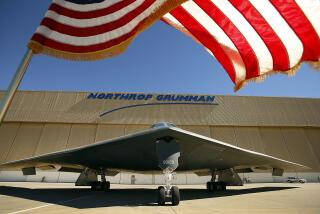Delivery of Missile Sensors Is Delayed
- Share via
Lockheed Martin Corp. and Northrop Grumman Corp. are at least 18 months late delivering infrared sensors for the Pentagon’s new $8.6-billion early missile-warning satellite system, the Air Force said.
The sensor delivery delay is the third in the last year for the project, which is building a constellation of missile-warning satellites and ground stations that are key to President Bush’s missile defense plan. The seven-satellite program was reorganized in late 2001 because of $3 billion in cost overruns and a two-year delay in launch dates to 2006 and 2007.
The delivery, now planned for July, could slip further to June 2005 -- 29 months behind the original date, January 2003, according to documents prepared for congressional staff. Flaws in testing the sensors were found in December, four months after Northrop was told its poor performance might hurt its ability to win future contracts, a spokesman in the Air Force’s Los Angeles-based space and missile command said in an e-mail.
“The delayed delivery will likely have long-term consequences for the remainders of the program,” the General Accounting Office said last week. Money and staff needed for the other sensors and satellites were pulled to fix the current problems, the GAO said.
“As a result, the program will likely encounter additional delays,” it said. Through Sept. 30, $3.6 billion had been spent.
Lockheed, the largest U.S. defense contractor, is the prime contractor on the Space Based Infrared System-High project. Century City-based Northrop is the main subcontractor, developing satellite-mounted sensors intended to station above the North and South Poles and detect launches of missiles from Russia and China.
Lockheed and Northrop are working to resolve the outstanding test issues that involve identifying and blocking electronic emissions from the sensor that could disrupt the host satellite’s other missions, the companies said.
The Air Force discovered in December that a piece of test equipment the contractors bought in early 2003 was improperly configured to measure all the emission frequencies. The recent tests belatedly uncovered frequencies that had been missed and need to be fixed, the Air Force said.
Northrop’s facility in Azusa is working on overall design and development of the sensors. The plant is part of Northrop’s Electronic Systems unit, which accounted for $6 billion of the company’s $26 billion in 2003 sales.
Lockheed’s Missiles Space Systems unit in Sunnyvale, Calif., is overseeing the program. It contributed $6 billion of the Bethesda, Md.-based company’s $31.8 billion in sales last year.
Lockheed shares fell 3 cents to $46.66 on Monday, and Northrop rose $1.69 to $101.01, both on the New York Stock Exchange.
More to Read
Inside the business of entertainment
The Wide Shot brings you news, analysis and insights on everything from streaming wars to production — and what it all means for the future.
You may occasionally receive promotional content from the Los Angeles Times.










